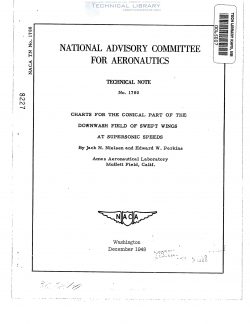naca-tn-1780
- Version
- 43 Downloads
- 1.15 MB File Size
- 1 File Count
- December 6, 2016 Create Date
- December 6, 2016 Last Updated
National Advisory Committee for Aeronautics, Technical Notes - Charts for the Conical Part of the Downwash Field of Swept Wings at Supersonic Speeds

Analytical expressions have been derived for the downwash
throughout the entire induced flow field of lifting triangles of
infinite chord with leading edges either in front of or behind the
Mach cone. These expressions have been determined from the line-
pressure source theory of R. T. Jones and the lifting—triangle
investigationqu H. J. Stewart. Based on these analytical results,
downwash charts have been prepared from.which the downwash field
may be determined for any practical combination of leading—edge sweep
angle and flight Mach number. These charts for the lifting triangle
of infinite chord are basic to the solution for the downwash field
of any finite swept wing wherein the contributions of the tips and
the trailing edges are to be determined by the method of lift can—
cellation as employed by Lagerstrom and others. The conical part
of the downwash is obtained from the charts, and the nonccnical
part must be obtained by other means such as the lift—cancellation
method.
One of the principal requirements for a rational analysis of
the longitudinal stability of aircraft is a knowledge of the down-
wash field behind lifting surfaces. Theoretical methods based on
lifting—line theory for determining downwash for conventional lifting
surfaces at subsonic speeds are well known. However, before satis—
factory agreement between experiment and theory was obtained, the
theoretical downwash had to be corrected for the local effects of
the wake and the vertical displacement of the trailing vortex sheet
(e.g., reference 1). The methods of reference 1 are applicable to
conventional airplanes throughout the subcritical speed range by
use of the GlauertéPrandtl rule (reference 2). No practical method
exists at present for the calculation of downwash in the supercritical
speed range.
Several methods based on solutions of the linearized differ—
ential equation of compressible flow are available for determining
the theoretical dowmash at supersonic speeds. By the use of the
conical flow theory of Busemnn (reference 3), Lagerstrom in refer-
ence 1} has developed analytical expressions for the downwash field
of certain uniformly loaded lifting surfaces. By superposition of
these lifting surfaces, Iagerstrom has determined the downwash field
of a flat rectangular wing and a flat trapezoidal wing. In addition
he has indicated a method for determining the effect on the downwash
field of adding a trailing edge to a lifting triangle of infinite '
chord to form a finite wing. Heaslet and Lomx (reference 5) have
determined the downwash for points along the intersection of the
chord plane with the vertical plane of symmetry behind a finite tri—
angular wing with subsonic leading edges. They have also determined
an approximate solution for the downwash in the vicinity of this line
at an infinite distance behind the wing.
| File | Action |
|---|---|
| naca-tn-1780 Charts for the Conical Part of the Downwash Field of Swept Wings at Supersonic Speeds.pdf | Download |
Comment On This Post